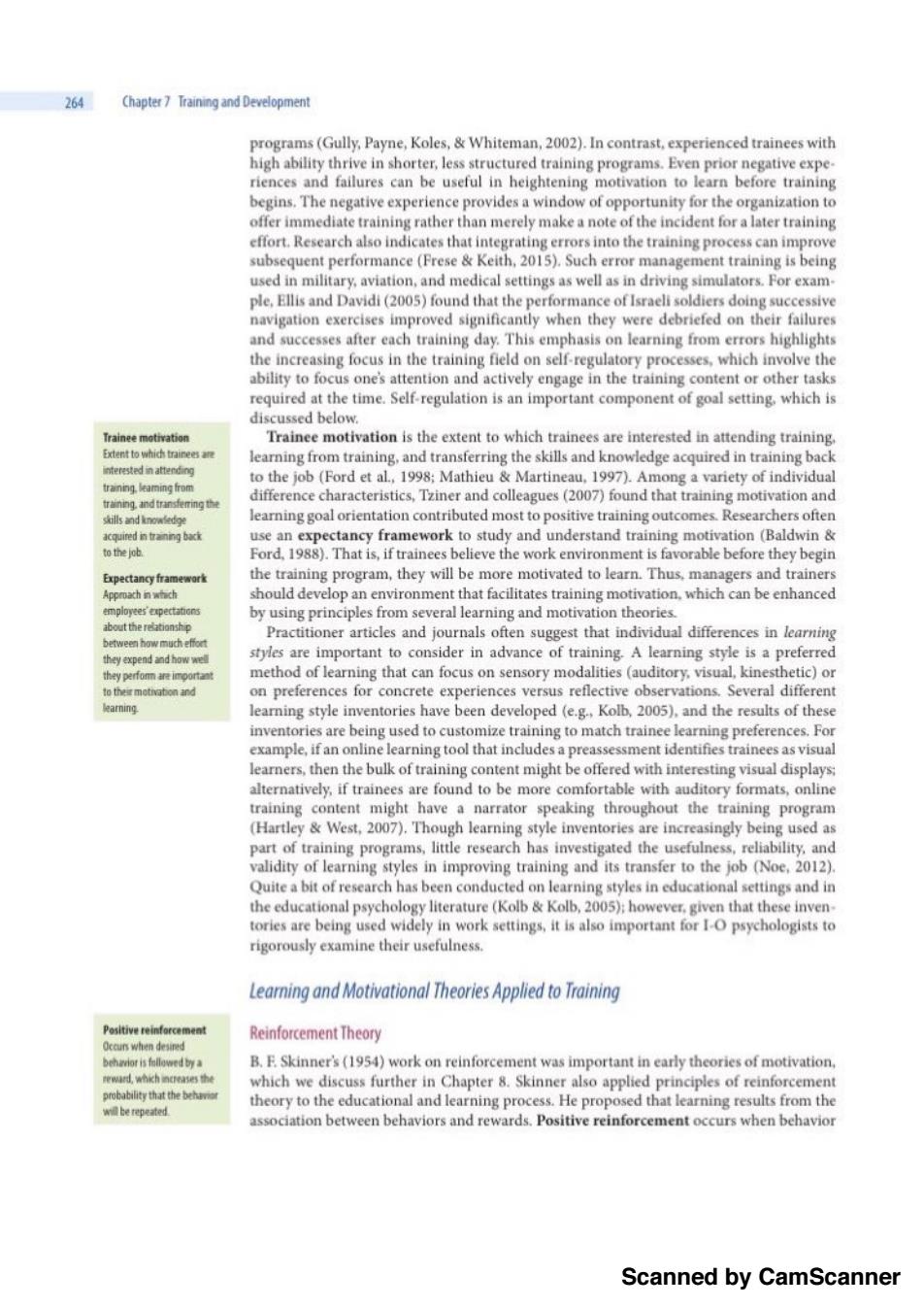正在加载图片...

264 Chapter7 Training and Development programs(Gully,Payne,Koles,Whiteman,2002).In contrast,experienced trainees with high ability thrive in shorter,less structured training programs.Even prior negative expe- riences and failures can be useful in heightening motivation to learn before training begins.The negative experience provides a window of opportunity for the organization to offer immediate training rather than merely make a note of the incident for a later training effort.Research also indicates that integrating errors into the training process can improve subsequent performance (Frese Keith,2015).Such error management training is being used in military,aviation,and medical settings as well as in driving simulators.For exam- ple,Ellis and Davidi(2005)found that the performance of Israeli soldiers doing successive navigation exercises improved significantly when they were debriefed on their failures and successes after each training day.This emphasis on learning from errors highlights the increasing focus in the training field on self-regulatory processes,which involve the ability to focus one's attention and actively engage in the training content or other tasks required at the time.Self-regulation is an important component of goal setting.which is discussed below. Trainee motivation Trainee motivation is the extent to which trainees are interested in attending training. Extent to which trainees are learning from training,and transferring the skills and knowledge acquired in training back interestedinattending to the job(Ford et al.,1998;Mathieu Martineau,1997).Among a variety of individual traning.leaming from difference characteristics,Tziner and colleagues(2007)found that training motivation and training and transfeming the skillsand nowed learning goal orientation contributed most to positive training outcomes.Researchers often acquired n traning back use an expectancy framework to study and understand training motivation (Baldwin to the job Ford,1988).That is,if trainees believe the work environment is favorable before they begin Expectancy framework the training program,they will be more motivated to learn.Thus,managers and trainers Approach in which should develop an environment that facilitates training motivation,which can be enhanced employees'expectations by using principles from several learning and motivation theories. about the relationshp Practitioner articles and journals often suggest that individual differences in learning between how much effort they expend and how well styles are important to consider in advance of training.A learning style is a preferred they perfom are important method of learning that can focus on sensory modalities(auditory.visual,kinesthetic)or to their metivabon and on preferences for concrete experiences versus reflective observations.Several different learning learning style inventories have been developed (e.g,Kolb,2005),and the results of these inventories are being used to customize training to match trainee learning preferences.For example,if an online learning tool that includes a preassessment identifies trainees as visual learners,then the bulk of training content might be offered with interesting visual displays: alternatively,if trainees are found to be more comfortable with auditory formats,online training content might have a narrator speaking throughout the training program (Hartley West,2007).Though learning style inventories are increasingly being used as part of training programs,little research has investigated the usefulness,reliability,and validity of learning styles in improving training and its transfer to the job (Noe,2012). Quite a bit of research has been conducted on learning styles in educational settings and in the educational psychology literature (KolbKolb,2005);however,given that these inven- tories are being used widely in work settings,it is also important for I-O psychologists to rigorously examine their usefulness. Learning and Motivational Theories Applied to Training Positive reinforcement Reinforcement Theory Occurs when desine时 behaior is fellowed的a B.F.Skinner's (1954)work on reinforcement was important in early theories of motivation. 接wrd.which increases the which we discuss further in Chapter 8.Skinner also applied principles of reinforcement probability that the beh theory to the educational and learning process.He proposed that learning results from the w量be repeate association between behaviors and rewards.Positive reinforcement occurs when behavior Scanned by CamScannerScanned by CamScanner